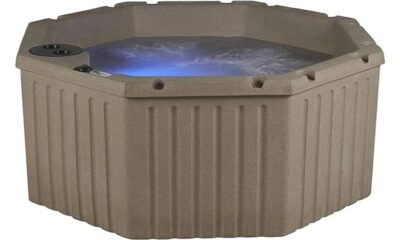Beginners Guides
What Temp Do You Cook Pancakes on a Griddle
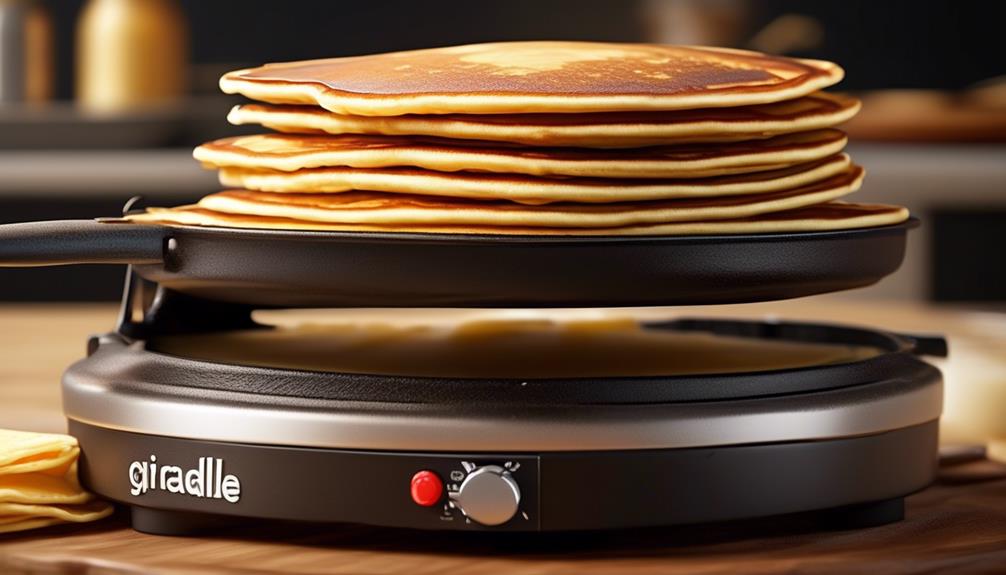
When it comes to making pancakes on a griddle, it’s important to find the perfect temperature that is not too hot or too cold. The right temperature is crucial in getting that ideal golden brown crust and fluffy texture on the inside.
But how do we determine the right temperature for our griddle? Join us as we explore the science behind griddle heat and uncover the secrets to cooking the most scrumptious pancakes.
Key Takeaways
- Preheat the griddle to 375 degrees Fahrenheit for perfect pancakes
- Proper griddle seasoning improves heat distribution and prevents sticking
- Adjust the heat for different pancake types – lower heat for fluffy pancakes, hotter heat for thin pancakes
- Consistent heat throughout cooking is crucial for even cooking and desired texture
Understanding the Ideal Cooking Temperature
To achieve the perfect pancake, it's essential to preheat the griddle to a temperature of 375 degrees Fahrenheit. This temperature allows for even heat distribution across the griddle surface, ensuring that each pancake cooks consistently. When the griddle reaches this optimal temperature, the pancake batter will immediately start to cook upon contact, creating a golden-brown exterior while maintaining a fluffy interior.
The griddle surface plays a crucial role in achieving the desired pancake texture. Its smooth, flat surface allows the batter to spread evenly, resulting in uniformly shaped pancakes. Additionally, the even heat distribution prevents hot spots, which can lead to uneven cooking and ultimately affect the pancake's texture and appearance.
Understanding heat distribution is key to mastering the art of cooking pancakes on a griddle. It ensures that each pancake receives the same amount of heat, leading to a consistent outcome. When the griddle surface is properly heated and the heat is distributed evenly, it sets the stage for creating a batch of delicious, perfectly cooked pancakes.
Tips for Testing Griddle Heat
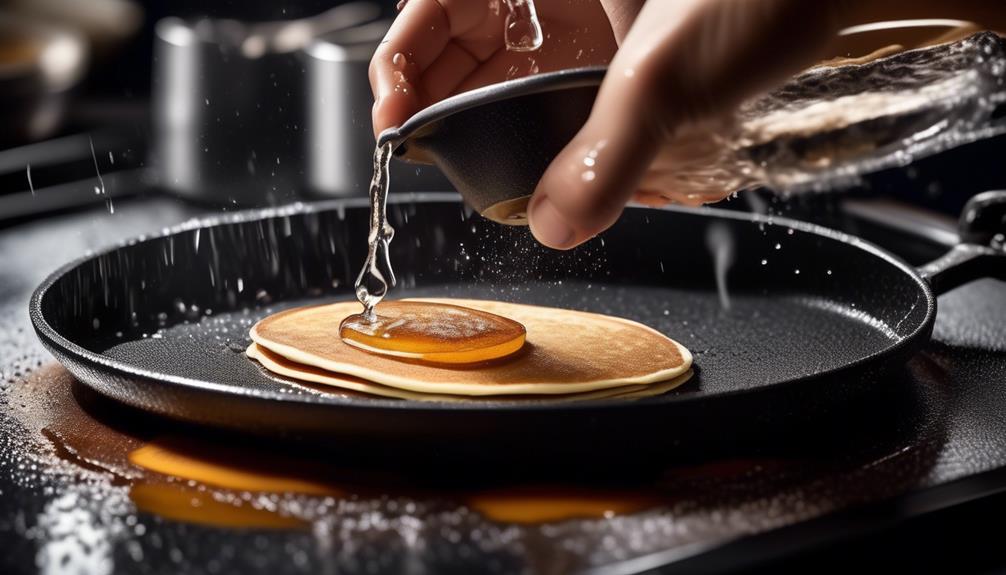
After preheating the griddle, we recommend testing the temperature by splashing a few drops of water onto the surface. This method helps gauge the heat level without the need for a thermometer. If the water droplets sizzle and evaporate quickly, the griddle is likely hot enough for cooking. However, if the water just sits and bubbles, the griddle may not be hot enough, and if the water instantly evaporates, the griddle is too hot and needs to be cooled down.
Griddle seasoning plays a crucial role in heat distribution and can affect the accuracy of testing the griddle heat. Properly seasoned griddles tend to have more even heat distribution, making it easier to achieve the desired cooking temperature across the entire surface. Additionally, the seasoning layer helps prevent food from sticking and promotes better heat transfer, allowing for consistent and predictable cooking results.
Understanding these tips for testing griddle heat, in conjunction with maintaining proper griddle seasoning and heat distribution, will enhance your mastery of griddle cooking, ensuring that you achieve the perfect cooking temperature for your pancakes and other delicacies.
Adjusting Heat for Different Pancake Types
For achieving optimal results, adjust the heat settings based on the specific type of pancake being cooked. Different types of pancakes require different heat levels to achieve the perfect texture and flavor. Here's how to adjust the heat for different pancake types:
- Fluffy vs. Thin Pancakes: Fluffy pancakes, such as buttermilk or blueberry pancakes, benefit from cooking on a slightly lower heat to ensure that the insides cook through without burning the outsides. On the other hand, thin pancakes, like crepes or Swedish pancakes, require a hotter griddle to quickly set the batter without overcooking.
- Flipping Techniques: When cooking fluffy pancakes, wait for bubbles to form on the surface before flipping. This indicates that the bottom is cooked and ready to be turned. For thin pancakes, they cook quickly, so flip them as soon as the edges start to brown, usually within a minute or less.
- Consistency: Maintaining a consistent heat level is crucial for both types of pancakes. Adjust the heat as needed throughout the cooking process to ensure that each batch turns out perfectly.
- Experimentation: Don't be afraid to experiment with the heat settings to find the perfect balance for your favorite pancake recipes.
Maintaining Consistent Heat Throughout Cooking

Maintaining a consistent heat level is crucial for both fluffy and thin pancakes, ensuring that they cook evenly and achieve the desired texture. Heat distribution plays a vital role in this process. When cooking pancakes on a griddle, it's essential to ensure that the entire cooking surface maintains the same level of heat. Inconsistent heat can lead to uneven cooking, resulting in some pancakes being undercooked while others are overcooked.
To maintain consistent heat throughout cooking, it's important to preheat the griddle properly. This allows the cooking surface to reach an even temperature, reducing the likelihood of hot spots that can affect the pancakes' cooking. Additionally, choosing a griddle with good heat distribution properties can greatly assist in achieving consistent results. An even cooking surface ensures that all areas of the griddle heat up uniformly, which is essential for producing perfectly cooked pancakes.
Regularly monitoring and adjusting the heat during the cooking process is also crucial. By making small, precise adjustments to the temperature, you can counteract any fluctuations and maintain consistent heat across the entire cooking surface. This attention to heat distribution and the cooking surface will help you achieve mastery in cooking pancakes to perfection.
Avoiding Common Cooking Temperature Mistakes
To achieve perfect pancakes, we must be mindful of potential mistakes in maintaining consistent cooking temperatures. Mastering the art of pancake making requires precise temperature control and flawless cooking techniques. Here are some common temperature mistakes to avoid:
- Inconsistent Heat Distribution: Ensure that the griddle is evenly heated before pouring the pancake batter. Hot spots can lead to uneven cooking and browning.
- Overheating the Griddle: Resist the temptation to crank up the heat to cook the pancakes faster. Overheating can result in burnt exteriors and undercooked centers.
- Underestimating Preheating Time: Allow the griddle to preheat for the recommended time to achieve the ideal cooking temperature. Rushing this step can lead to inconsistent results.
- Neglecting Adjustments: Make necessary temperature adjustments throughout the cooking process to maintain a consistent heat level. Factors such as batter quantity and room temperature can affect the griddle's temperature.
Frequently Asked Questions
Can I Use a Griddle to Cook Pancakes on an Outdoor Grill?
We've found that using an outdoor griddle on a grill is a fantastic way to cook pancakes. It allows for even heat distribution and a larger cooking surface.
To get the ideal grill temperature, aim for around 350-375°F.
When cooking, wait for bubbles to form on the surface before flipping the pancake.
This method can result in perfectly cooked pancakes with a delicious outdoor flavor.
What Type of Heat Source Is Best for Cooking Pancakes on a Griddle?
When cooking pancakes on a griddle, achieving the best temperature is crucial for that perfect golden-brown finish.
We've found that an electric heat source provides more precise control, akin to a skilled conductor leading an orchestra.
The even distribution of heat ensures consistent results.
However, a gas heat source can also be effective if the griddle is properly preheated.
It's ultimately a matter of preference and mastering the nuances of your chosen heat source.
How Can I Tell if My Griddle Is Hot Enough Without a Thermometer?
To check the griddle's temperature without a thermometer, we can use the water droplet test.
After seasoning the griddle, sprinkle a few droplets of water on the surface.
If the droplets sizzle and evaporate quickly, the griddle is hot enough for pancakes.
This method is a handy way to gauge temperature without a thermometer and ensures the griddle is properly seasoned for cooking pancakes.
Are There Any Special Considerations for Cooking Gluten-Free Pancakes on a Griddle?
When cooking gluten-free batter on a griddle, it's crucial to ensure the nonstick surface is well-prepared. This may involve using nonstick spray or a light coating of oil to prevent sticking.
Additionally, monitoring the heat is vital for achieving the perfect texture and browning. It's a delicate balance between a too-hot griddle, which can lead to uneven cooking, and a too-cold one, resulting in undercooked pancakes.
Can I Use a Different Type of Cooking Oil or Spray on the Griddle Besides Traditional Vegetable Oil?
We usually use olive oil when cooking pancakes on the griddle. It's a great non-stick alternative and adds a nice flavor to the pancakes. Make sure not to use too much, as it can affect the texture.
Other non-stick sprays like coconut oil can also work well. Just a light coating is sufficient. These alternatives are great if you're looking to switch things up from traditional vegetable oil.
Is There a Specific Temperature Range for Cooking Pancakes on a Griddle?
The best temperature for pancakes on a griddle is around 375-385 degrees Fahrenheit. This allows for even cooking and a golden-brown color. It’s important to preheat the griddle and adjust the temperature as needed during the cooking process to achieve the perfect texture and flavor.
Conclusion
So, next time you're making pancakes on a griddle, remember to preheat to 375°F and adjust as needed.
Test the heat with a few drops of water and keep it consistent for perfect pancakes every time.
Don't let common temperature mistakes ruin your breakfast – take control of the griddle and enjoy delicious, fluffy pancakes.
Happy cooking!
- About the Author
- Latest Posts
Introducing Ron, the home decor aficionado at ByRetreat, whose passion for creating beautiful and inviting spaces is at the heart of his work. With his deep knowledge of home decor and his innate sense of style, Ron brings a wealth of expertise and a keen eye for detail to the ByRetreat team.
Ron’s love for home decor goes beyond aesthetics; he understands that our surroundings play a significant role in our overall well-being and productivity. With this in mind, Ron is dedicated to transforming remote workspaces into havens of comfort, functionality, and beauty.
Beginners Guides
Ceiling Fan Only Has One Speed
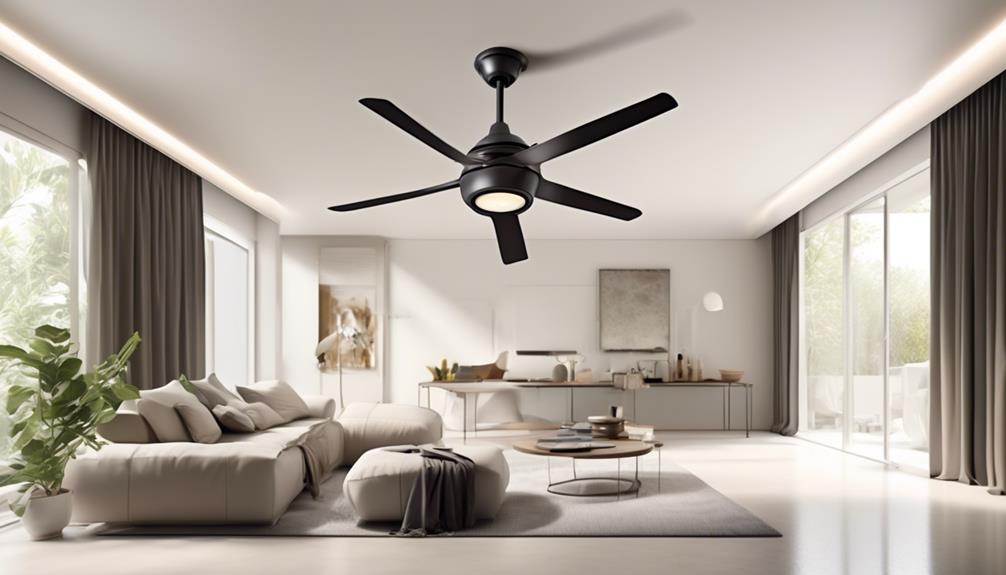
We have all encountered the annoyance of a ceiling fan that appears to be fixed at one speed, making us feel uncomfortable in our own houses.
But before you rush to replace the entire unit, there are a few factors that could be causing this limitation.
From remote control malfunctions to wiring and connection issues, there are several potential culprits behind your ceiling fan's lack of variability.
So, what could be causing this vexing problem, and how can it be resolved?
Key Takeaways
- Check the fan speed setting on the remote control or pull chain to ensure it is set correctly.
- Examine the motor and wiring for any loose connections or damaged components that may be affecting the fan speed.
- Consider installing a fan speed control switch or upgrading to a newer fan model with enhanced speed settings for more control options.
- If troubleshooting fails, consider seeking professional assistance or exploring capacitor replacement to resolve any speed control issues.
Fan Speed Setting
We can adjust the fan speed by using the remote control or the pull chain. If the fan is only operating at one speed, there are troubleshooting steps that we can take to address the issue.
First, we should check the remote control or pull chain to ensure that the fan speed isn't inadvertently set to a specific setting. Sometimes, a simple adjustment of the speed setting can resolve the issue. Additionally, we can examine the fan's motor and wiring to see if there are any loose connections or damaged components that could be causing the speed limitation.
In some cases, if troubleshooting doesn't resolve the problem, there are upgrading options available. One potential upgrading option is to install a fan speed control switch, which can provide more precise control over the fan's speed settings. Upgrading to a newer, more advanced fan model with enhanced speed settings and controls could also be a viable solution.
Exploring these upgrading options may offer a more permanent and effective resolution to the ceiling fan speed issue.
Remote Control Malfunction

When troubleshooting a ceiling fan speed issue, a common culprit to consider is a malfunctioning remote control. If the fan only operates at one speed or doesn't respond to speed adjustments, the remote control may be the source of the problem. To address this issue, a series of troubleshooting steps can be taken.
| Issue | Resolution |
|---|---|
| Weak remote signal | Ensure the remote has fresh batteries and is pointed directly at the receiver on the fan. |
| Interference issues | Reposition the fan's receiver to minimize potential interference from other electronic devices. |
| Receiver replacement | If troubleshooting steps fail, consider replacing the receiver to restore proper remote functionality. |
It's important to ensure that the remote control is functioning properly to avoid unnecessary fan speed issues. By following these troubleshooting steps and considering receiver replacement if necessary, you can effectively address remote control malfunctions and restore the fan's functionality.
Capacitor Problems
Addressing the ceiling fan speed issue caused by a malfunctioning remote control, we now turn our attention to potential capacitor problems. When dealing with capacitor issues, it's crucial to troubleshoot effectively and consider the possibility of a capacitor replacement if necessary. Here are some troubleshooting tips to help you identify and resolve capacitor problems:
- Check for Physical Damage: Inspect the capacitor for any signs of physical damage such as bulging or leaking. If you notice any damage, it's likely that the capacitor needs to be replaced.
- Test the Capacitor: Use a multimeter to test the capacitor for proper functionality. A significant deviation from the rated capacitance indicates a faulty capacitor that should be replaced.
- Consult a Professional: If troubleshooting and testing the capacitor prove challenging, seek assistance from a qualified electrician or technician. They can accurately diagnose the issue and perform a capacitor replacement if required.
Wiring and Connections
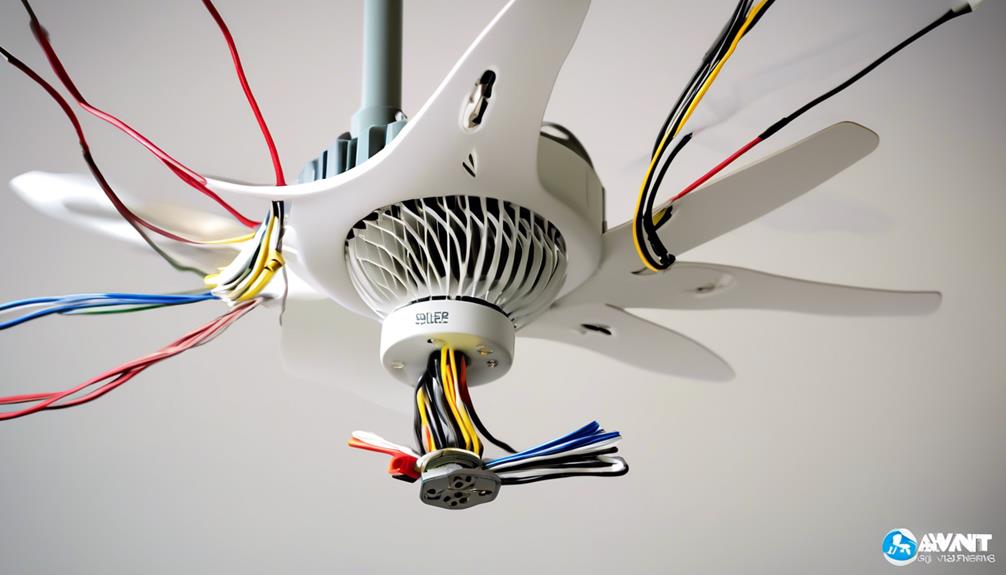
Inspecting the wiring and connections for any signs of wear or loose fittings is crucial in diagnosing potential issues with the ceiling fan's speed control. When troubleshooting the speed problem of a ceiling fan, it's imperative to examine the wiring and connections for any irregularities that could be causing voltage fluctuations.
Voltage fluctuations can result from loose connections or damaged wiring, which can directly impact the functioning of the speed control mechanism. Electrical troubleshooting techniques such as using a multimeter to check for continuity and proper voltage levels across the connections can help identify and rectify any wiring or connection issues.
In addition, ensuring that the connections are securely fastened and free from corrosion or damage is essential for optimal fan performance. By carefully examining the wiring and connections, we can effectively address potential causes of the speed control malfunction, restoring the fan to its proper functionality.
Motor Issues
After inspecting the wiring and connections for any irregularities, we can now turn our attention to potential motor issues affecting the ceiling fan's speed control. When it comes to motor maintenance and troubleshooting tips, there are several key areas to consider:
- Lubrication: Lack of proper lubrication can cause the motor to operate inefficiently, leading to speed control issues. Regularly lubricating the bearings and moving parts can help maintain optimal performance.
- Capacitor Malfunction: A faulty capacitor can result in the motor running at only one speed. Inspecting the capacitor for bulges, leaks, or other signs of damage is essential. Replacing a defective capacitor can often resolve speed control problems.
- Internal Wiring: Internal wiring issues within the motor can also lead to speed control problems. Carefully examining the wiring for any signs of damage or disconnection is crucial. Additionally, checking the motor windings for continuity can help identify any underlying issues.
Frequently Asked Questions
Can the Ceiling Fan Speed Be Adjusted Manually if the Remote Control Is Malfunctioning?
Yes, if the remote control is malfunctioning, the ceiling fan speed can be adjusted manually.
Troubleshooting techniques for manual adjustment include checking the fan's pull chain or wall switch, adjusting the fan's settings directly on the motor housing, or using a universal remote if available.
It's important to refer to the fan's manual for specific instructions on manual speed adjustment to ensure proper handling and avoid damage to the fan.
Are There Any Common Signs That Indicate a Problem With the Capacitor in a Ceiling Fan?
When troubleshooting a ceiling fan, signs of a faulty capacitor include the fan running at only one speed or not starting at all. We mustn't overlook the importance of examining the capacitor when dealing with such issues.
In case the remote control malfunctions, manually adjusting the fan speed is an option.
Understanding these signs and solutions can help us master the art of ceiling fan repair.
How Often Should the Wiring and Connections in a Ceiling Fan Be Inspected for Potential Issues?
We should regularly inspect the wiring and connections in a ceiling fan for potential issues to ensure safety and proper functioning. This maintenance helps identify any wear and tear, loose connections, or other electrical problems that could lead to malfunctions or safety hazards.
What Are Some Signs That the Motor in a Ceiling Fan May Be Failing?
Motor failure in a ceiling fan can manifest in various ways. Signs include excessive noise, wobbling, or the fan running at inconsistent speeds.
To troubleshoot, check for loose connections, dust accumulation, or worn-out bearings. Interestingly, 75% of ceiling fan motor failures are due to lack of maintenance.
Regularly inspecting the motor and addressing any issues promptly can extend its lifespan.
Can a Ceiling Fan With Only One Speed Be Easily Converted to Have Multiple Speed Settings?
Yes, a ceiling fan with only one speed can be easily converted to have multiple speed settings.
You can replace the ceiling fan motor with one that has multiple speed options.
Additionally, troubleshooting tips for the remote control can help diagnose any issues related to the speed settings.
Can the Shutters on the Back of My House Affect the Speed of My Ceiling Fan?
Yes, the shutters on the back of house shutters can affect the speed of your ceiling fan. If the shutters are closed, they can restrict airflow and potentially slow down the fan. It’s important to keep the shutters open to allow for proper air circulation and to maintain the efficiency of the fan.
Conclusion
In conclusion, fixing a ceiling fan with only one speed can be as frustrating as trying to cook without any spices – it just doesn't work the way it's supposed to.
By checking the fan speed setting, remote control, capacitor, wiring, and motor, you can troubleshoot and fix the issue.
Remember, just like adding the perfect seasoning to a dish, getting your fan to work properly will make a world of difference in your home.
- About the Author
- Latest Posts
Introducing Ron, the home decor aficionado at ByRetreat, whose passion for creating beautiful and inviting spaces is at the heart of his work. With his deep knowledge of home decor and his innate sense of style, Ron brings a wealth of expertise and a keen eye for detail to the ByRetreat team.
Ron’s love for home decor goes beyond aesthetics; he understands that our surroundings play a significant role in our overall well-being and productivity. With this in mind, Ron is dedicated to transforming remote workspaces into havens of comfort, functionality, and beauty.
Beginners Guides
Best Way to Vent a Double Wide Roof
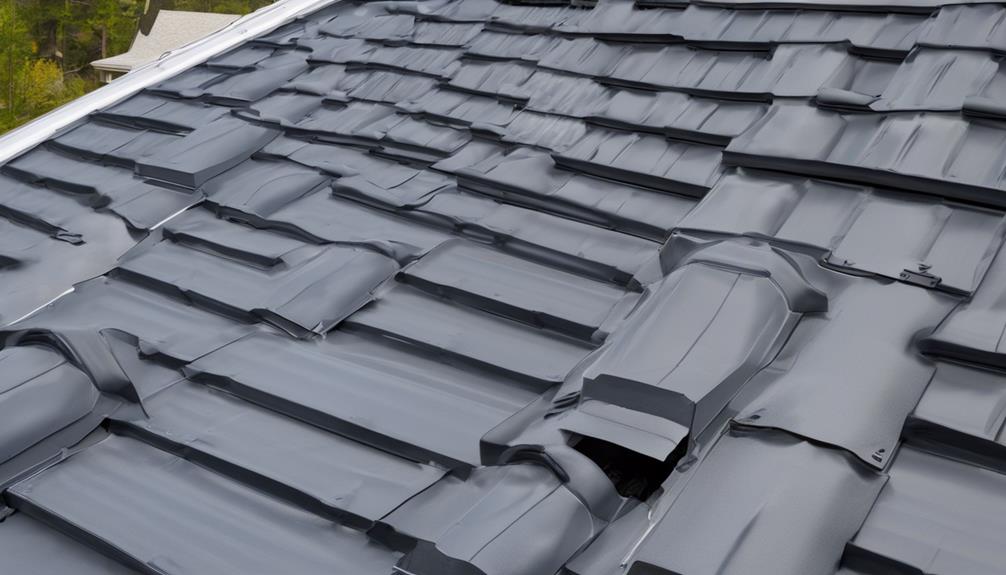
When it comes to making sure a double wide roof has proper ventilation, it is crucial to think about the long-term effects on the building’s structure and the indoor environment.
We all know that adequate ventilation is crucial for maintaining a healthy and efficient living space, and this holds especially true for double wide roofs.
But with so many options available, how do we determine the best approach?
Well, the answer lies in understanding the various types of roof vents, their installation process, and the benefits they bring.
So, let's uncover the most effective way to vent a double wide roof and why it's worth exploring.
Key Takeaways
- Proper ventilation is essential for maintaining the longevity and structural integrity of double wide mobile homes.
- Adequate ventilation helps in managing heat and energy efficiency by preventing heat buildup and reducing energy costs.
- Ventilation plays a crucial role in preventing premature deterioration of the roof materials by removing hot air and moisture.
- Choosing the right ventilation system based on climate considerations is important for a healthy and structurally sound living environment.
Importance of Roof Ventilation
Ensuring proper roof ventilation is crucial for maintaining the longevity and structural integrity of a double wide mobile home. Adequate ventilation plays a pivotal role in heat management and energy efficiency within the home. Without proper ventilation, heat can become trapped in the attic space, causing the temperature inside the home to increase. This can lead to higher energy costs as the air conditioning system works harder to cool the interior. Additionally, excessive heat buildup in the attic can also contribute to premature deterioration of the roof materials, leading to costly repairs or replacements.
Proper roof ventilation allows for the removal of hot air and moisture from the attic, creating a more comfortable living environment while also protecting the roofing materials. By facilitating air movement, ventilation helps regulate the temperature in the attic space, preventing heat from transferring into the living areas below. This not only enhances energy efficiency but also extends the lifespan of the roof, ultimately saving homeowners money in the long run.
Effective roof ventilation is an essential component of maintaining a comfortable, energy-efficient, and structurally sound double wide mobile home.
Types of Roof Vents
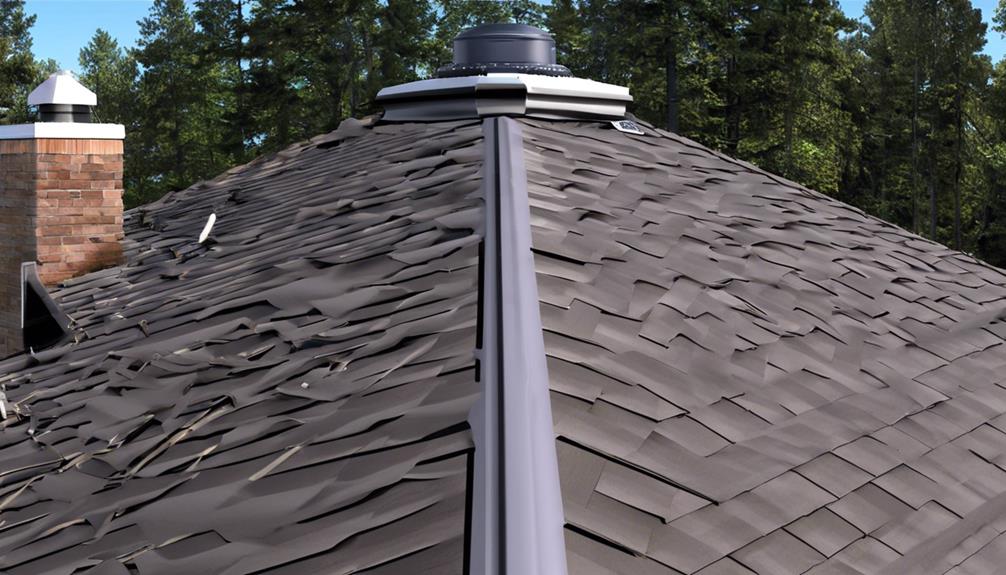
Proper roof ventilation is crucial for maintaining the longevity and structural integrity of a double wide mobile home. Understanding the different types of roof vents is essential for achieving optimal ventilation.
When considering ventilation options, it's important to be knowledgeable about the various types of roof vents available. This knowledge empowers us to make informed decisions that can impact the overall well-being of our homes.
As we delve into the world of roof vent options, we may experience a sense of empowerment, knowing that we have the ability to make a positive impact on our living environment.
Additionally, understanding the importance of ventilation maintenance can elicit a feeling of responsibility and care for our homes. By being diligent in the maintenance of our roof vents, we can take pride in knowing that we are actively preserving the structural integrity of our double wide mobile homes and ensuring a healthy living environment for ourselves and our loved ones.
Choosing the Right Ventilation System
Selecting the appropriate ventilation system for a double wide mobile home is crucial for maintaining a healthy and structurally sound living environment. When considering ventilation options, it's essential to take into account the climate considerations of the region where the double wide is located.
In warmer climates, where heat and humidity are prevalent, powered roof vents or ridge vents are effective choices. These ventilation systems facilitate the release of hot air, preventing moisture buildup and reducing the strain on air conditioning systems.
In contrast, in colder climates, where winters are harsh, it's important to ensure that the ventilation system prevents ice dams and condensation. In such regions, a combination of soffit vents and a ridge vent can help maintain a balanced airflow while preventing moisture-related issues.
Additionally, in areas prone to severe weather, homeowners may want to consider impact-resistant vents to safeguard against damage.
Installation Process for Roof Vents

When installing roof vents for a double wide mobile home, it's essential to consider the climate-specific factors and the chosen ventilation system to ensure an effective and structurally sound installation. Proper roof vent placement is crucial to maximize airflow and prevent moisture buildup. Additionally, ensuring proper insulation around the vents is vital to maintain energy efficiency and prevent heat loss or gain.
It's important to take into account the following points to evoke emotion in the audience:
- Enhanced Comfort: Properly installed roof vents contribute to a more comfortable indoor environment by regulating temperature and reducing humidity, creating a more enjoyable living space.
- *Emotional Appeal*: Imagine the peace of mind and comfort you'll experience knowing your home has optimal ventilation, creating a cozy and inviting atmosphere for you and your family.
- Energy Efficiency: A well-installed ventilation system can lead to energy savings by reducing the strain on heating and cooling systems, ultimately lowering utility bills and environmental impact.
- *Emotional Appeal*: Visualize the satisfaction and pride in knowing that your home isn't only comfortable but also environmentally responsible, contributing to a sustainable future for generations to come.
Benefits of Proper Roof Ventilation
An effective roof ventilation system ensures improved air circulation, which can prevent moisture accumulation and extend the lifespan of the roofing materials. Proper roof ventilation offers a range of benefits, from energy efficiency to moisture control, and from heat dispersion to air circulation. Here are some key benefits of proper roof ventilation:
| Benefits of Proper Roof Ventilation |
|---|
| Energy Efficiency |
| Proper roof ventilation helps in maintaining a consistent indoor temperature, reducing the load on heating and cooling systems, and ultimately leading to energy savings. |
| Moisture Control |
| By allowing moist air to escape, proper roof ventilation prevents condensation and moisture buildup, which can lead to mold, mildew, and rot in the attic and the roofing materials. |
| Heat Dispersion |
| During hot weather, proper roof ventilation allows heat to escape from the attic, reducing the strain on air conditioning systems and helping to maintain a comfortable indoor environment. |
Frequently Asked Questions
How Can I Tell if My Double Wide Roof Needs Better Ventilation?
We can tell if a double wide roof needs better ventilation by looking for signs such as:
- Excessive heat buildup
- Condensation
- Mold growth
Proper ventilation is crucial for maintaining a healthy and efficient roof system. Understanding ventilation needs is essential to prevent damage and increase energy efficiency.
It's important to address any ventilation issues promptly to ensure the longevity and performance of the roof.
Are There Any Specific Regulations or Codes I Need to Follow When Installing Roof Vents on a Double Wide?
When installing roof vents on a double wide, it's crucial to adhere to regulations and requirements to ensure proper ventilation.
DIY installation can be tempting, but professional expertise ensures compliance and effectiveness.
Before installation, a ventilation assessment is key to determine the best approach.
Maintenance and cleaning are also vital for optimal performance.
Following regulations and seeking professional installation guarantees a well-ventilated double wide roof.
Can I Install Roof Vents on My Double Wide Roof Myself, or Should I Hire a Professional?
We believe that DIY installation of roof vents on a double wide roof is feasible for those with experience. However, hiring a professional ensures proper ventilation and compliance with regulations.
Adequate ventilation is crucial for controlling attic temperature and preventing moisture buildup. Regular roof vent maintenance is also essential.
We recommend considering the complexity of the task and your expertise before deciding between DIY and professional help.
What Are Some Common Mistakes to Avoid When Venting a Double Wide Roof?
When venting a double wide roof, it's crucial to avoid common mistakes for proper installation. Improving airflow and preventing damage are key.
As the saying goes, 'measure twice, cut once.' Common mistakes include improper vent placement, insufficient venting, and using the wrong type of vents.
Proper installation is essential to ensure effective ventilation and prevent issues down the line. It's best to consult with a professional to avoid these pitfalls.
Are There Any Maintenance or Cleaning Tasks I Need to Perform to Keep My Double Wide Roof Vents Functioning Properly?
To keep our double wide roof vents functioning properly, we need to perform regular cleaning maintenance and ensure proper insulation.
Cleaning the vents regularly prevents debris buildup and mold growth, which can impede airflow.
Additionally, maintaining proper insulation helps regulate temperature and moisture levels, preserving the effectiveness of the vents.
These tasks are crucial for ensuring optimal ventilation and prolonging the lifespan of our double wide roof.
Conclusion
In conclusion, proper roof ventilation is essential for maintaining a healthy and functional home.
By choosing the right ventilation system and ensuring it's installed correctly, you can prevent issues such as moisture buildup, mold growth, and excessive heat in the summer.
A well-ventilated roof won't only extend the lifespan of your double wide roof but also create a comfortable and efficient living environment for you and your family.
- About the Author
- Latest Posts
Introducing Ron, the home decor aficionado at ByRetreat, whose passion for creating beautiful and inviting spaces is at the heart of his work. With his deep knowledge of home decor and his innate sense of style, Ron brings a wealth of expertise and a keen eye for detail to the ByRetreat team.
Ron’s love for home decor goes beyond aesthetics; he understands that our surroundings play a significant role in our overall well-being and productivity. With this in mind, Ron is dedicated to transforming remote workspaces into havens of comfort, functionality, and beauty.
Beginners Guides
American Mixes

As we explore the diverse blend of American cultures, it is clear that our cultural landscape is a fusion of various influences that have come together to form a complex and fascinating mosaic.
The complexities of these mixes are not just limited to their origins, but also extend to the unique traits and characteristics they embody.
Exploring the depth of American mixes allows us to uncover a fascinating array of flavors and traditions that have been shaped by a multitude of influences.
This exploration invites us to consider the ways in which these mixes reflect the evolving identity of America and its people, urging us to ponder the significance of embracing such diversity in our society.
Key Takeaways
- American mixes reflect the rich history and culinary traditions of the United States, showcasing the influences of Native American tribes, European settlers, African slaves, and immigrants.
- American mixes are a harmonious blend of flavors from different culinary traditions, resulting in regional specialties with unique mix of flavors and cooking techniques.
- American mixes exhibit hybrid vigor and are generally healthier than purebred dogs, making them excellent companions with lower veterinary costs in the long run.
- Embracing the individuality of American mixes means celebrating their uniqueness, understanding their specific needs and behaviors, and appreciating the value of cultural diversity in society.
Origins of American Mixes

The origins of American mixes can be traced back to a diverse range of cultural influences, reflecting the rich history and culinary traditions of the United States. America is often referred to as a melting pot, where people from various cultural backgrounds have come together, bringing with them their unique culinary practices and ingredients. This fusion of diverse influences has significantly shaped American cuisine, giving rise to a wide array of food mixes that are now integral to the country's culinary identity.
The cultural influences on American mixes are extensive, stemming from the traditions of Native American tribes, early European settlers, African slaves, and later waves of immigrants from Asia, Latin America, and the Middle East. Each group contributed distinct flavors, cooking techniques, and ingredients, leading to the development of dishes that showcase a blend of traditions. For instance, the introduction of ingredients like tomatoes, peppers, and corn from the Native American and Latin American cultures significantly impacted the evolution of American cuisine.
Understanding the cultural influences behind American mixes provides a profound insight into the diverse tapestry of flavors and culinary innovations that have come to characterize the nation's food landscape.
Diversity in American Mixes

Reflecting on the diverse cultural influences that have shaped American mixes, it becomes evident that the resulting culinary landscape is a testament to the rich tapestry of flavors and traditions brought together in the United States. The diversity in American mixes is a reflection of the varied cultural influences that have shaped the nation's cuisine, leading to a rich tapestry of flavors and unique characteristics.
- Fusion of Flavors: American mixes showcase a harmonious blend of flavors from different culinary traditions, such as the fusion of Mexican spices with American barbecue or the incorporation of Asian ingredients into traditional American dishes.
- Regional Specialties: The diverse cultural influences in America have given rise to regional specialties, with each area boasting its own unique mix of flavors and cooking techniques, from the Cajun and Creole influences in the South to the Scandinavian and German influences in the Midwest.
- Culinary Innovations: The melding of cultural influences has spurred culinary innovation, leading to the creation of entirely new dishes and cooking styles that have become an integral part of American cuisine, exemplifying the dynamic nature of American mixes.
The unique characteristics of American mixes are a testament to the nation's cultural diversity, resulting in a culinary landscape that continues to evolve and captivate food enthusiasts worldwide.
Common Traits of American Mixes
Upon examining the culinary landscape of American mixes, a distinct set of common traits emerges, revealing the intricate fusion of flavors and techniques that characterize this diverse culinary tradition. American mixes often exhibit a remarkable temperament, combining the best of their diverse heritage. They come in a wide array of size and coloring, reflecting the rich tapestry of their ancestral lineages. Additionally, health is a key consideration when it comes to these mixes, as breeders and owners alike strive to maintain their well-being and vitality.
To further illustrate the common traits of American mixes, we have compiled a table detailing these characteristics:
| Common Traits | Description |
|---|---|
| Temperament | Friendly, adaptable, and sociable, reflecting the diverse influences that shape their personalities. |
| Size and Coloring | Varied in size, from small to large, and boasting an extensive range of colors, patterns, and coat textures. |
| Health | Generally robust and resilient, but may inherit specific health considerations from their mixed heritage. |
These common traits highlight the captivating blend of attributes that define American mixes, making them truly unique and cherished companions.
Benefits of Adopting American Mixes

Adopting American mixes brings a multitude of benefits to households seeking lively companions with diverse backgrounds and adaptable personalities.
The advantages of welcoming an American mix into your home are numerous and compelling. Firstly, these mixes often exhibit hybrid vigor, a phenomenon where they're generally healthier and more robust than purebred dogs due to their diverse genetic backgrounds. This can lead to fewer genetic health issues and lower veterinary costs in the long run.
Secondly, their varied ancestry can result in a unique combination of traits, making them adaptable to different environments and lifestyles. This adaptability is particularly appealing for families with varying schedules or living situations.
Lastly, American mixes are often known for their exceptional personalities, blending the best traits from their various ancestral lines. Their diverse backgrounds contribute to their well-rounded and flexible temperament, making them highly trainable and adaptable to different households.
Embracing the Individuality of American Mixes
With their diverse heritage and unique blend of traits, American mixes stand out as individual companions, each with its own distinct character and charm. Celebrating the uniqueness of American mixes is essential in understanding and appreciating the cultural fusion that makes them so special. Embracing their individuality allows us to recognize the rich tapestry of influences that have shaped these remarkable companions.
The beauty of American mixes lies in their diverse backgrounds, which contribute to their one-of-a-kind personalities. By celebrating their uniqueness, we acknowledge the significance of their cultural fusion and the stories woven into their genetic makeup. Embracing their individuality also means understanding and respecting their specific needs, behaviors, and health considerations, which can vary widely based on their heritage.
Furthermore, by embracing the individuality of American mixes, we open ourselves up to a deeper understanding of the world around us. We learn to appreciate the complexities of cultural diversity and the beauty of blending traditions. Ultimately, celebrating the uniqueness of American mixes enriches our lives and reinforces the value of diversity in our society.
Frequently Asked Questions
What Are Some Common Health Issues That American Mixes May Be Prone To?
Common illnesses and genetic predispositions can vary widely among different dog breeds. It's important to research the specific health issues and exercise requirements of any mixed breed.
Mental stimulation is also crucial for their overall well-being. Proper care and regular check-ups are essential to catch any potential health concerns early.
Understanding the unique needs of each mix is key to providing them with a healthy and fulfilling life.
How Can I Best Train and Socialize an American Mix?
When training and socializing a dog, it's important to use positive reinforcement techniques to encourage good behavior.
Consistent training, socialization with other dogs and people, and exposure to various environments can help prevent behavioral challenges.
Regular exercise is also crucial to keep your dog healthy and well-behaved.
Are There Specific Dietary Considerations for American Mixes?
When it comes to dietary restrictions and nutritional requirements, it's essential to consider the specific needs of the individual.
Factors such as age, activity level, and any health conditions should all be taken into account when determining the best diet.
Understanding the unique dietary needs of a particular breed or mix can help ensure that they receive the proper balance of nutrients for optimal health and well-being.
What Is the Average Lifespan of an American Mix?
The average lifespan of a dog depends on various factors such as genetic predispositions, medical care, exercise needs, and behavioral training. These elements play a significant role in determining the overall health and longevity of a dog.
Proper medical care, regular exercise, and behavioral training can contribute to a longer and healthier life for our furry friends. It's essential to consider these aspects to ensure our dogs live a fulfilling and healthy life.
Are There Any Specific Grooming Needs for American Mixes?
When it comes to grooming tips, it's crucial to understand the specific coat maintenance required for different breeds. Regular brushing and bathing are essential for keeping your dog's coat healthy and free from mats and tangles.
Additionally, understanding your dog's specific coat type will help determine the appropriate grooming tools and techniques. Consistent grooming not only keeps your dog looking their best but also contributes to their overall health and well-being.
What Other American Mixes Are Available Besides Pancake Mixes?
In addition to delicious American pancake mix, there are also other popular American mixes available. Some options include waffle mix, cornbread mix, and biscuit mix. These convenient mixes make it easy to whip up a variety of tasty treats in no time.
Conclusion
In conclusion, American mixes are like a beautiful patchwork quilt, each with its own unique combination of traits and characteristics. Embracing the individuality of these mixes not only adds diversity to our lives, but also brings a sense of inclusivity and acceptance.
By understanding their origins, appreciating their diversity, and recognizing their common traits, we can truly see the beauty and value in adopting American mixes into our lives.
- About the Author
- Latest Posts
Introducing Ron, the home decor aficionado at ByRetreat, whose passion for creating beautiful and inviting spaces is at the heart of his work. With his deep knowledge of home decor and his innate sense of style, Ron brings a wealth of expertise and a keen eye for detail to the ByRetreat team.
Ron’s love for home decor goes beyond aesthetics; he understands that our surroundings play a significant role in our overall well-being and productivity. With this in mind, Ron is dedicated to transforming remote workspaces into havens of comfort, functionality, and beauty.
-

 Vetted2 weeks ago
Vetted2 weeks ago15 Best Contact Paper for Kitchen Cabinets to Elevate Your Home Decor
-

 Vetted4 days ago
Vetted4 days ago15 Best Poe Cameras for Home Security – Reviews & Buying Guide
-

 Vetted3 weeks ago
Vetted3 weeks ago15 Best Leather Restorer Products to Revive Your Furniture and Accessories
-

 Vetted4 weeks ago
Vetted4 weeks ago15 Best Leg Massagers to Relieve Tension and Improve Circulation – Ultimate Guide
-

 Vetted2 weeks ago
Vetted2 weeks ago15 Best Drain Snakes to Unclog Your Pipes Like a Pro
-

 Vetted4 weeks ago
Vetted4 weeks ago15 Best Lawn Games for Adults to Elevate Your Outdoor Gatherings
-

 Vetted2 weeks ago
Vetted2 weeks ago14 Best Stationery Brands for Your Next Writing Adventure
-

 Beginners Guides7 days ago
Beginners Guides7 days agoSwinger Porch Light Color


















